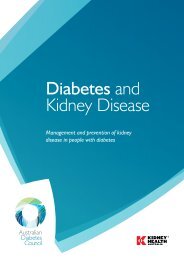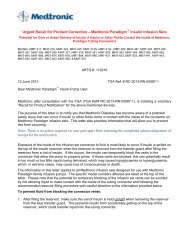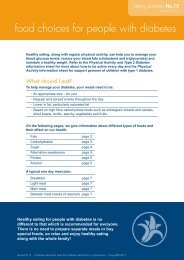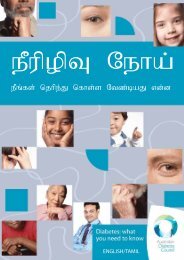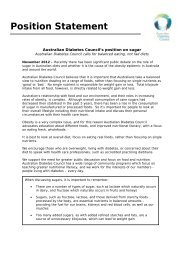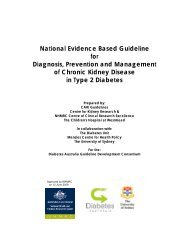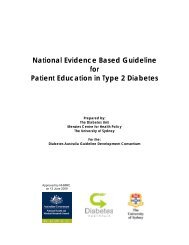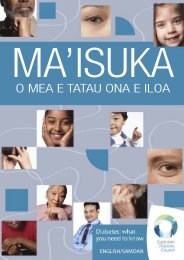Part 6: Detection and Prevention of Foot Problems in Type 2 Diabetes
Part 6: Detection and Prevention of Foot Problems in Type 2 Diabetes
Part 6: Detection and Prevention of Foot Problems in Type 2 Diabetes
Create successful ePaper yourself
Turn your PDF publications into a flip-book with our unique Google optimized e-Paper software.
Background - <strong>Detection</strong> <strong>of</strong> Loss <strong>of</strong> Protective <strong>Foot</strong> SensationPeripheral neuropathy is common <strong>in</strong> people with <strong>Type</strong> 2 diabetes <strong>and</strong> was present <strong>in</strong>12.3% <strong>of</strong> people participat<strong>in</strong>g <strong>in</strong> the United K<strong>in</strong>gdom Prospective <strong>Diabetes</strong> Study atdiagnosis <strong>and</strong> <strong>in</strong> approximately 30% after 12 years (UKPDS 33, 1998). As reviewed<strong>in</strong> Section 1 peripheral neuropathy is a major risk factor for both foot ulceration <strong>and</strong>amputation. Therefore its cl<strong>in</strong>ical detection is important <strong>in</strong> identify<strong>in</strong>g feet at risk <strong>of</strong>ulceration <strong>and</strong> is pivotal for effective strategies to prevent foot ulceration <strong>and</strong>amputation.One <strong>of</strong> the ma<strong>in</strong> objectives <strong>of</strong> the foot exam<strong>in</strong>ation <strong>in</strong> the primary care sett<strong>in</strong>g is todetect a level <strong>of</strong> peripheral neuropathy which significantly <strong>in</strong>creases the risk <strong>of</strong>susta<strong>in</strong><strong>in</strong>g a foot wound, which is def<strong>in</strong>ed as ‘loss <strong>of</strong> protective sensation’. This is one<strong>of</strong> the most important criteria <strong>in</strong> identify<strong>in</strong>g people at high-risk <strong>of</strong> foot problems <strong>and</strong>is paramount <strong>in</strong> implement<strong>in</strong>g a structured management plan to prevent lowerextremity complications (Armstrong et al, 1998). The detection <strong>of</strong> loss <strong>of</strong> protectivesensation is an important <strong>in</strong>dicator to both the person with diabetes <strong>and</strong> the primarycarer that more frequent review <strong>and</strong> suitable preventative actions should be <strong>in</strong>stituted<strong>and</strong> necessitates behavioural change <strong>in</strong> both the person with diabetes <strong>and</strong> the doctor.Several methods have been used to assess peripheral neuropathy <strong>in</strong> cl<strong>in</strong>ical studies<strong>and</strong> <strong>in</strong>clude:• the 10g Semmes-We<strong>in</strong>ste<strong>in</strong> mon<strong>of</strong>ilament• vibration perception threshold (VPT) measured us<strong>in</strong>g a biothesiometer or 128Hztun<strong>in</strong>g fork• calculation <strong>of</strong> a neuropathy score based on:− symptoms - the University <strong>of</strong> Texas Subjective Peripheral Neuropathyquestionnaire which relies on 4 questions <strong>of</strong> symptoms <strong>of</strong> neuropathy (Dyck,1988) or− cl<strong>in</strong>ical exam<strong>in</strong>ation - the neuropathy disability score derived from acomb<strong>in</strong>ation <strong>of</strong> test<strong>in</strong>g for pa<strong>in</strong>, temperature <strong>and</strong> vibration threshold with thepresence or absence <strong>of</strong> ankle reflexes (Young et al, 1993b)Symptoms alone are not considered reliable because a significant proportion <strong>of</strong> peoplewith diabetes who have neuropathy are asymptomatic (Young & Matthews, 1998).Similarly test<strong>in</strong>g <strong>of</strong> ankle jerks alone is <strong>of</strong> little value s<strong>in</strong>ce they are frequently absent<strong>in</strong> the elderly population, with or without diabetes (de Hens-van Putten et al, 1996)<strong>and</strong> has not been as successful as the more objective measures (eg VPT) <strong>in</strong> predict<strong>in</strong>gulceration or amputation <strong>in</strong> people with diabetes.The primary care sett<strong>in</strong>g requires a simple, cheap <strong>and</strong> reliable means <strong>of</strong> identification<strong>of</strong> the foot which has lost protective sensation (the <strong>in</strong>sensate foot) <strong>and</strong> has led to the<strong>in</strong>creas<strong>in</strong>g popularity <strong>of</strong> the 10g Semmes-We<strong>in</strong>ste<strong>in</strong> mon<strong>of</strong>ilament. The mon<strong>of</strong>ilamentconsists <strong>of</strong> a pressure sensitive nylon filament attached to a rod. The mon<strong>of</strong>ilamentbuckles at a reproducible pressure <strong>of</strong> 10g force which has been identified as the level<strong>of</strong> sensation protective aga<strong>in</strong>st foot ulceration, <strong>in</strong>itially <strong>in</strong> leprosy (Birke & Sims,1986; Halar et al, 1987). The loss <strong>of</strong> this protective sensation at one site is taken as<strong>in</strong>dicat<strong>in</strong>g an abnormal mon<strong>of</strong>ilament test. The test must be performed <strong>in</strong> areas free <strong>of</strong>callus which may impair the ability to feel the mon<strong>of</strong>ilament.41




